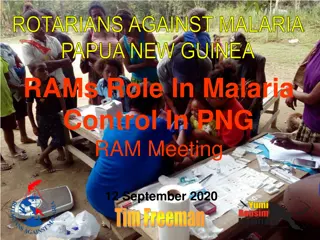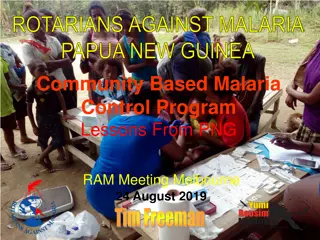Understanding Malaria: Causes, Symptoms, and Prevention
Malaria is an infectious disease caused by the Plasmodium parasite, transmitted through the bite of a female Anopheles mosquito. There are four types of Plasmodium parasites, with Plasmodium falciparum being the most severe. Malaria incidence globally has seen millions of cases with significant mortality rates. The disease is transmitted when an infected mosquito bites a person, passing on the parasites. Symptoms include fever, headache, and body aches, which can range from mild to severe. Proper treatment and prevention strategies are crucial in combating this potentially life-threatening disease.
Download Presentation

Please find below an Image/Link to download the presentation.
The content on the website is provided AS IS for your information and personal use only. It may not be sold, licensed, or shared on other websites without obtaining consent from the author. Download presentation by click this link. If you encounter any issues during the download, it is possible that the publisher has removed the file from their server.
E N D
Presentation Transcript
Malaria April Health Theme
What is MALARIA? Malaria is an infectious disease caused by a parasite called plasmodium of which there are four types and is spread by Female Anopheles Mosquitoes: The four types of plasmodium parasites are 1. Plasmodium Falciparum (PF) If left untreated, can lead to severe malaria causing shock, brain injury/damage, kidney & liver failure, coma and death 2. Plasmodium Vivax (PV) If left untreated, can remain in the liver causing sickness for years or recur at irregular times for months or years. May also cause severe malaria at times 3. Plasmodium Ovale (PO) - Recurrence similar to PV with milder symptom 4. Plasmodium Malariae (PM) If left untreated, can recur after several months/years Malaria caused by Plasmodium falciparum can be life threatening if not treated properly. 2
Malaria Statistics in Brief In 2017 An estimated 219 million cases world-wide an increase by 2 million from 217 million cases in 2016 An estimated 435 000 died globally an increase by 16 000 compared from 451000 In PNG, 478,340 case were reported of which 3000 deaths occurred In Tabubil, about 802 positive cases of Malaria were reported in 2018. OTML Employees 133, OTML Dependents 77, Contractor employees 381 Contractor dependents 32. 3
Malaria Incidence in OTML Operational Sites Annual Malaria Incidence in Tabubil for OTML Operational Sites, 2006-2018 Malaria Incidence Tabubil Hospital Statistics 700 Number of new cases per 1000 people 600 587.61 500 400 325.26 300 200 199 147 100 25 33 28 32 100.18 20 24 30 0 16 2014 2004 2006 2008 2010 2012 2016 2018 2020 -100 -200 Malaria Incidence Rate per 1000 Linear (Malaria Incidence Rate per 1000) Health Facility Year Confirmed Malaria Cases Lost Work Days Bige OTML Clinic 2017 150 121.2 2018 172 115 Kiunga OTML Clinic 2017 396 150.5 2018 373 147.5 Tabubil Hospital 2017 736 N/A 2018 802 N/A
How Malaria Parasites are Transmitted by Mosquitoes Flies over and Bites a infected person with malaria during a blood meal Sick person Malaria Causing Mosquito Infected mosquito Healthy Person Bitten by Infected Mosquito Healthy Person becomes Sick after 7 21 days A female anopheles mosquito bites a person who is sick with malaria during a blood meal and draws/sucks malaria parasites into its system. The parasites are then injected into the next person (healthy person) during another blood meal. The parasites grow and start to destroy the body s red blood cells and the person starts to feel sick after 7 30 days after being bitten 5
Symptoms and Treatment of Malaria Clinical symptoms of malaria can range from very mild to severe: Fever and flu-like illness that may come and go Headache Backache Joint aches and pain Muscle ache Tiredness Nausea and vomiting And diarrhoea Because of the loss of red blood cells, anaemia and jaundice(yellow colouring of skin and eyes) can occur. Note: Not all the above symptoms need to be present. Malaria should be suspected if you have any of these symptoms, even if they are mild seek medical help immediately. 6
Diagnosis and Treatment of Malaria Diagnosing Malaria A Rapid Diagnostic Test (RDT) is done once malaria is suspected. Result is made available in 10 -15 minutes A Blood Slide is taken at the same time to confirm the diagnosis Treatment Always Take the Doses as prescribed at the Right Time Complete your medications for the Duration of Time as prescribed Do Not Stop medications early You can develop resistance if you continue to miss medications 7
Preventing Malaria Personal Protection Clothing Cover as much of your skin as possible by wearing long pants, a long sleeved shirt, shoes and socks. Wear light coloured clothes Wear insect-treated clothing when working on night- shift Insecticides are available as soaks and sprays and usually lasts through several wash Insect Repellent Apply insect repellent that contains at least 20% DEET to exposed skin Reapply after swimming or excessive sweating Read directions provided on the labels Be aware that allergic reactions can occur in some people 8
Preventing Malaria Personal Protection Sleeping Quarters Ensure window and door screens are undamaged and fit snugly to frame. Sleep under insecticide treated mosquito nets. If sleeping outdoors, treat bedding and clothing with insecticide. Use knock-down aerosol sprays to kill mosquitos inside the building. Air conditioning also helps to keep the mosquito away. 9
Preventing Malaria General Protection Programs Mosquito Identification Program Vector Mosquito surveillance and monitoring - Provide detailed information about the number and type of mosquito in the area. Also provides information about the occurrence and distribution certain vector species within a control region. Breeding site monitoring Program Mosquito breeding activity surveillance - Regular monitoring provide information for preparing control and eradication treatments. Also provides information of a mosquito vector breeding activity. Drainage Program Prevent stagnant water build-up. Anopheles mosquito favours ground pools with an abundance of organic matter for breeding. 10
Preventing Malaria Removing Mosquito Breeding Habitat Anopheles mosquitos like to breed in: Salty, brackish and stagnant water Pig wallows Blocked drainage Swamps Puddles & wheel ruts Chemical Treatments Larvicidal Treatments can either be bacteria or insect hormonal growth regulators applied to stagnant water(ground pools especially) to control mosquito larvae Adulticide Chemicals chemicals used in fogging and spraying to control adult mosquitos. Indoor Residual Spraying process of spraying inside of dwellings with an insecticide to kill and deter mosquitos. Bed nets are also sprayed with insecticide. 11
Checklist for Malaria Control Company Malaria Control Program Implementation Checklist Program Components A-Workplace Malaria Awareness Workplace orientation for new hires include specific malaria control information for the location Malaria Survival Training for Expatriates and Rotating non-immune employees Discussions regarding malaria included at Safety Meetings conducted at Malaria High Risk Operational sites Distribution of Educational Materials and communication regarding Malaria Control Program Malaria Statistics communicated to Employees on a Monthly Basis. Malaria Awareness materials provided for Contractor and Employee dependents residing in company accommodations Coloring competition for Primary Schools and Malaria Awareness for Secondary School awareness. B-Bite Prevention: Personal Protection Mosquito/Insect Repellent (20% DEET) available and provided to personal in Malaria Risk Areas Factory Treated Clothing worn by employees in High Risk Malaria Areas. Long-sleeved Shirt/Pants worn at night shift at Malaria High Risk Operational sites YES NO N/A Comments Insecticide treated bed nets made available in company provided accommodations where mosquitos can enter freely Information Package Provided for Individual Employees Bite Prevention :Surveillance and Control Mosquito Surveillance providing information on abundance, distribution and diversity for control intervention. Temporary breeding site inspection and reduction done on a regular basis Larval surveillance providing information on malaria vector mosquito breeding activity Indoor Residual Treatment Program conducted on a regular basis Outdoor Residual Treatment Program conducted on a regular basis Routine Adulticiding (Fogging) Program C-Chemoprophylaxis Consider risks versus benefits based on risk assessment Relevant chemoprophylaxis medications readily available and provided for non immune personnel Specialist available if the employee has severe hepatic or renal impairment. Chloroquine or an appropriate drug used for malaria prophylaxis D-Diagnosis and Prompt Treament Advise employees regarding symptoms of malaria Screen employees with symptoms of Malaria in all site clinics using RDT kits Blood smear slide for RDT Postive and suspected cases of Malaria Promptly treat employees with positive Malaria E- Environment Mosquito breeding source Reduction - prevent stagnant water to build up in ground pools and containers. Plants/Trees with mosquito repelling properties distributed for planting in gardens and around the house. Encourage Proper exclusion practices (screen on windows and doors). 12
Summary Malaria is a preventable disease. Take responsibility to protect yourself and others from the disease. Wear protective clothing and apply insect repellent. Fill all ground pools and puddles. Don t let water stagnate in containers such as empty bottles, cans and old tyres. If you have cold or flu symptoms, seek site medical treatment quickly Follow site guidelines for the prevention of malaria Facts to Remember: Be aware of the risk Avoid being bitten by mosquitoes. Take antimalarial drugs(chemoprophylaxis) when visiting malaria endemic areas Immediately seek medical attention if symptoms develop. 13
For Further Information Contact the following: Tabubil OTML Clinic Ext: 3222 Employee Health & Wellness Ext: 3806 Folomian Clinic Ext: 3464 Bige Clinic Ext: 5179 Kiunga Clinic Ext 3711 14























